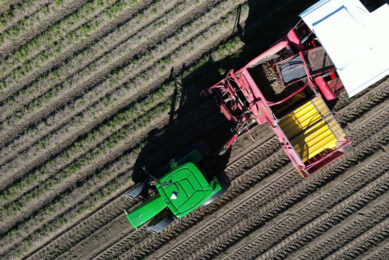Tarvos monitors insects with computer vision and AI

Intelligent traps are the next generation of monitoring of pests and diseases with computer vision, object recognition and artificial intelligence (AI).
Cotton
Cotton growing is an important sector for Brazilian agriculture. The Brazilian Association of Cotton Producers (Abrapa) expects that in the new cycle, the planting area can raise up to 1.4 million hectares, with production growing close to 2.3 million tons. The cotton ball weevil is the main pest and the damage caused by this insect in Brazil alone is over € 325 million.
Detection and monitoring
Although it is possible to control the boll weevil, to do so is costly in terms of insecticides and environmental impacts. Early and accurate detection of the presence of the insect is key. Therefore, traps baited with pheromones are used. A pheromone is a chemical that an animal produces which changes the behaviour of another animal of the same species. The principal of the use of insect sex pheromones is to attract insects to traps for detection and determination of temporal distribution. Careful monitoring and correct interpretation of the data collected are important for success. Because of the large size of cotton plantations numerous traps, one trap per 5 hectares, have to be monitored daily and the insects in the trap have to be identified and counted.
Automated traps
Tarvos offers pest monitoring solutions in an automated way. Based on data collected from the intelligent traps, predictive analyses of pest attacks can be made. Automated monitoring allows a daily view of all monitored areas of the property. The operation of intelligent traps is similar to that of traditional traps using pheromone as a form of attraction, and any commercially available synthetic pheromone recommended for the monitored pest can be used. In addition to this well-known system, smart traps use more sophisticated strategies such as the use of embedded cameras in the traps, computer vision and the use of artificial intelligence (AI) to make the correct differentiation of the species present. Embedded sensors for the counting of the captured insects. Internet-based communication technology (IoT) is used to send the data to the producer’s smart-phone. Thus, the producer receives daily reports as well as alert messages on his smart-phone when the pest reaches the control level.
Energy
Tarvos has 2 distinct approaches to the energy management of its devices installed in the fields. In one of the product lines, 3 pencil batteries installed in the equipment provide sufficient power to supply the electronic system during a whole crop. This autonomy is possible due to a smart system that is designed to remain in stand-by mode when there is no confirmed presence of new insects in the trap. In addition, work is in progress of the development of a new product line in which it is necessary to use photo-voltaic panels that guarantee electrical power necessary for more energy demanding computational processing activities in the traps.
Tarvos
Parallel to the boll weevil trap Tarvos is developing solutions for the cane-borer in sugar cane and caterpillars affecting crops. A major advantage of this approach is enabling faster and more accurate decision-making. Once the producer has access to the infestation data of the area daily, the control measures can be performed at the correct time, avoiding possible control failures. In addition, with automated monitoring, it is possible to target the application of pesticides only in those areas where control is really necessary, thus promoting a reduction of costs for the producer and at the same time reducing the environmental impact. In line with the proposal to reformulate the way pest and disease monitoring is done, Tarvos is working to present a digital, democratic and inclusive tool for the market later this year to empower the decision-making process of all sizes of producers and for all Brazilian agricultural crops. The solution concept is to digitise the process of manual data collection in the field, leading to much more agility and transparency for this operation. The digital tool will be available from September for free download for users of the Android system and later for users of the iOS system.
Join 17,000+ subscribers
Subscribe to our newsletter to stay updated about all the need-to-know content in the agricultural sector, two times a week.



